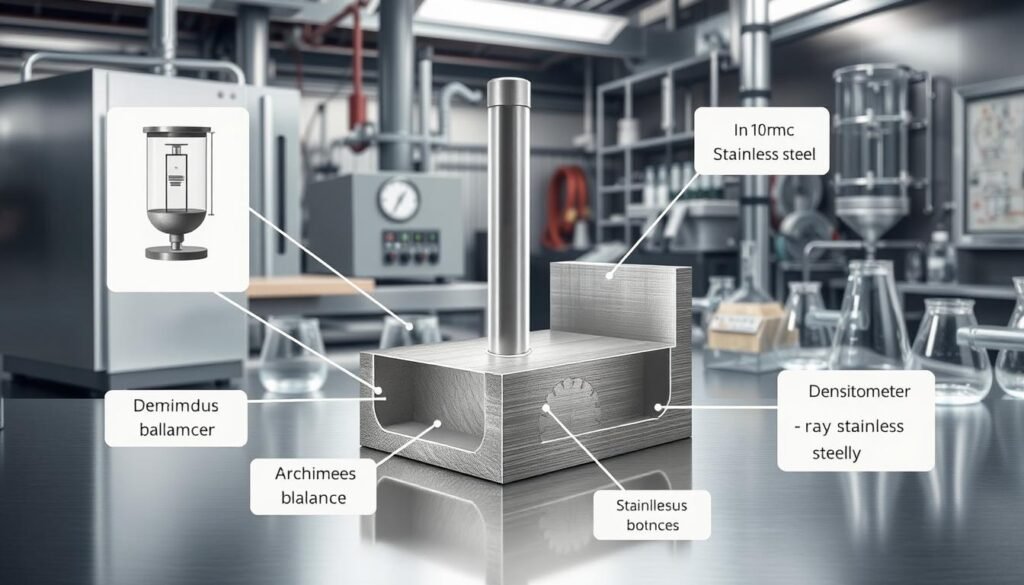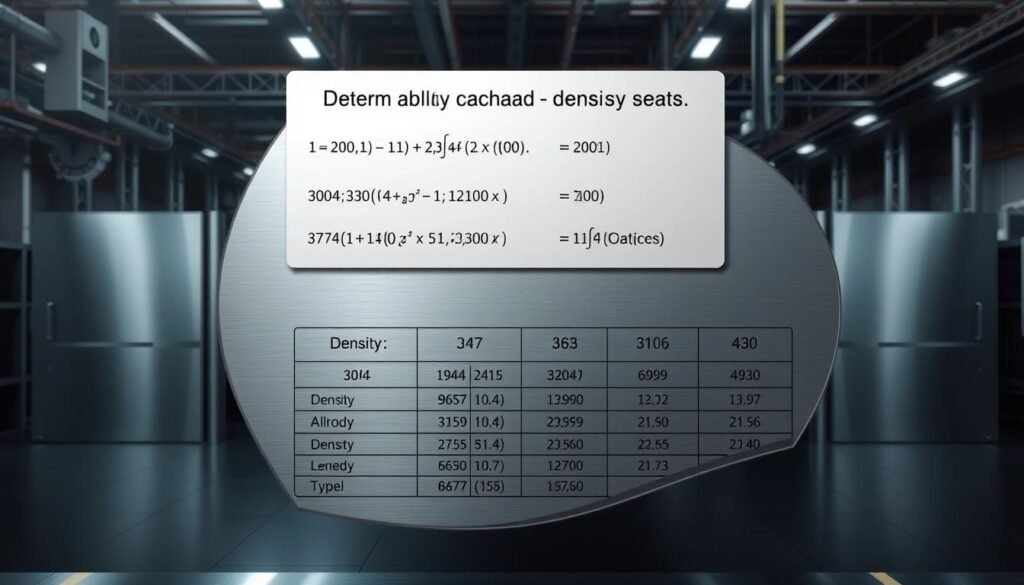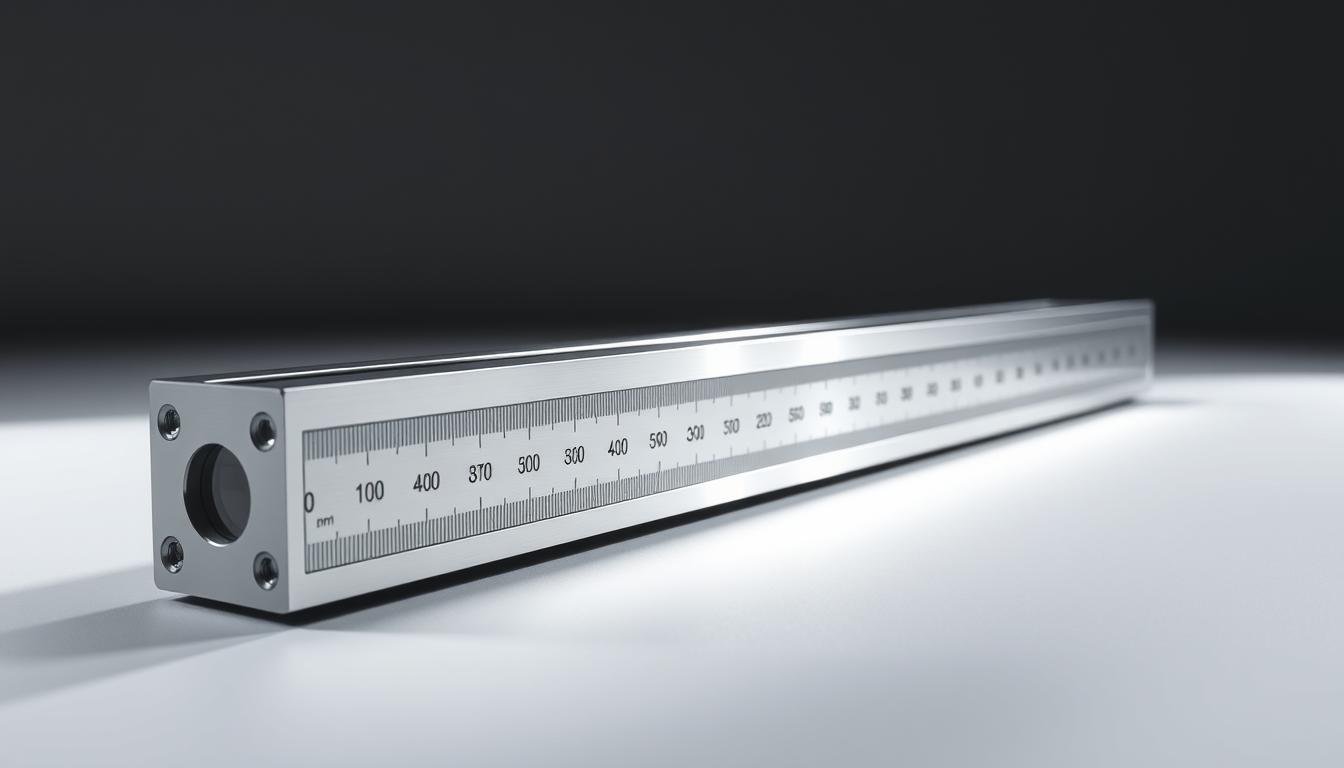Knowing the density of stainless steel is key in many fields. It affects what materials are chosen for building, engineering, and making things. This guide will help you understand stainless steel’s density, its benefits like being strong and resistant to rust, and its importance in real-world uses.
Understanding Density: The Basics of Stainless Steel
The density definition is about mass per unit volume. It’s key to understanding materials like stainless steel. The density of stainless steel is usually between 7.5 and 8.0 g/cm³. This range changes based on the alloy mix.
Knowing these stainless steel basics is important for those in construction and manufacturing. It helps them make better choices.
Density affects many things, like how strong something is and how it performs. It also decides if a material is right for a job. Designers and builders need to understand density to get the best results.
The connection between a material’s density and its use is strong. The right density makes a project work better and more efficiently. So, knowing about stainless steel’s density is very important.
What is Stainless Steel Density?
The stainless steel density definition tells us how much mass is in a certain volume of stainless steel. It’s usually shown in grams per cubic centimeter (g/cm³). The density can change based on the type and mix of stainless steel, ranging from about 7.5 to 8.0 g/cm³.
For instance, grades like 304 and 316 have a higher density, around 8.0 g/cm³. This is because they have a lot of nickel and chromium. These elements make the steel strong and resistant to corrosion.
Knowing about density is key in many uses, like picking materials for building or making things. There are different density types in stainless steel, depending on the mix of metals and how it’s made.
| Stainless Steel Grade | Typical Density (g/cm³) | Main Alloying Elements |
|---|---|---|
| 304 | 8.0 | Chromium, Nickel |
| 316 | 8.0 | Chromium, Nickel, Molybdenum |
| 430 | 7.7 | Chromium |
| 2205 | 7.8 | Chromium, Nickel, Molybdenum |

Factors Affecting Stainless Steel Density
Stainless steel density is influenced by several critical factors. Understanding these factors helps in determining the right grade and composition for various applications.
Alloy Composition
The primary alloying elements in stainless steel—iron, nickel, and chromium—play a significant role in determining density. For instance, higher nickel content typically increases density due to its higher atomic weight. Different grades of stainless steel, influenced by specific alloy composition, exhibit a density range from 7,600 kg/m³ to 8,000 kg/m³. Notably, austenitic stainless steels, such as grade 316, have a density of around 7,980 kg/m³, while grade 304 is approximately 7,930 kg/m³. Understanding the relationship between the elements and density allows manufacturers to tailor products for specific needs. Factors influencing density extend beyond mere atomic formulations, incorporating manufacturing efficiencies as well.
Manufacturing Processes
The method of production can significantly alter the density of stainless steel. Processes such as forging, casting, and cold rolling introduce variations that affect the finished product’s density. For instance, the grain structure obtained through these manufacturing processes impacts material strength and density.
Also, the presence of porosity resulting from manufacturing defects tends to reduce overall density. Thermal treatments may relieve internal stresses within the material but usually do not fundamentally change density. Knowledge of manufacturing processes can aid in optimizing stainless steel for durability and performance in diverse applications.
How to Measure the Density of Stainless Steel
To find the density of stainless steel, you need to know its mass and volume. The formula is Density = Mass ÷ Volume. Getting this right is key, mainly in making things and engineering.
For mass, use a precise balance to avoid mistakes. Volume depends on the shape of the steel. Simple shapes are easy to measure, but odd shapes need water displacement.
There are advanced ways to measure density more accurately. Hydrostatic weighing uses water to find mass. The pycnometer method uses a special flask to measure volume. Each method has its own benefits, making stainless steel measurement more precise.
| Measurement Technique | Method | Advantages |
|---|---|---|
| Hydrostatic Weighing | Utilizes buoyancy in a fluid | High accuracy for irregular shapes |
| Pycnometer | Measures volume in a sealed chamber | Suitable for small samples, high precision |
| Water Displacement | Measures displaced water volume | Simple and effective for irregularly shaped items |
| Geometric Calculation | Calculates volume based on dimensions | Quick method for regular shapes |

Comparative Density: Stainless Steel vs Other Metals
When picking materials for big projects, knowing about density is key. This part talks about how stainless steel stacks up against carbon steel and other metals. It shows how density differences affect what we choose.
Stainless Steel vs Carbon Steel
Carbon steel weighs about 7.85 g/cm³, which is less than most stainless steel types. Stainless steel’s higher density comes from chromium and nickel. These add to its strength and help it resist corrosion, making it a top pick for many uses.
Density Comparison with Common Metals
Looking at the density of different metals helps us see where stainless steel fits in. Here’s a table that compares stainless steel’s density with some other metals:
| Metal | Density (g/cm³) |
|---|---|
| Aluminum | 2.7 |
| Copper | 8.96 |
| Lead | 11.34 |
| Stainless Steel | 7.95 |
| Carbon Steel | 7.85 |
Knowing these density differences is vital for engineers and scientists. It helps them pick the best materials for projects, considering strength, weight, and cost.
How Does Density Vary Across Stainless Steel Grades?
Different stainless steel grades have varying densities. This affects their strength and how well they work in different situations. Knowing the details of each grade helps pick the best one for a job. Grades 304 and 316 are good examples, each with its own strengths but similar densities.
Exploring Grade 304
Grade 304 is a common, versatile stainless steel. It has a density of about 8.0 g/cm³. Its mix of elements makes it strong against corrosion and wear. It’s great for things like kitchen tools, food processing gear, and building parts.
Understanding Grade 316 Density
Grade 316 is a high-quality stainless steel with molybdenum added. It also has a density of around 8.0 g/cm³. The molybdenum boosts its fight against corrosion, even in salty or wet places. This shows how different grades, like 304 and 316, can serve different needs.
The Role of Stainless Steel Density in Applications
The density of stainless steel plays a big role in its applications of stainless steel in many fields. In construction, knowing the density is key for using materials wisely and building strong structures. This is very important for tall buildings and bridges, where keeping the weight down is essential.
In the aerospace and automotive fields, the right density is critical for better performance. The role of density helps manage weight, which affects how much fuel a vehicle uses and how well it performs. For example, using a lighter stainless steel can make a car go faster and use less fuel without losing strength.
In industries like marine, medical, and chemical processing, the right density of stainless steel matters a lot. Different types of stainless steel have different densities, making some better for certain jobs. Knowing this helps makers and engineers choose the right materials, leading to better results and safety.
If you want to learn more about how density affects stainless steel, there are detailed studies out there. These studies dive into the physics of materials. You can find more information on the measurements and what they mean for stainless online.
Calculating the Density of Stainless Steel
Getting the right density of stainless steel is key for engineers and makers. Knowing how to measure it ensures materials are up to standard.
Methodologies for Accurate Measurement
There are several ways to get precise density numbers. Some top methods are:
- Archimedes’ Principle: This method uses the volume of water a stainless steel piece displaces. It calculates density with the formula density = mass/volume.
- Pycnometer Method: This involves a special container, the pycnometer. It measures the mass of liquid and the sample for accurate density readings.
Using these methods helps avoid mistakes and keeps production quality high.
Common Density Values Across Grades
Knowing density values for different stainless steel grades is important. It helps make better material choices. Here’s a table with density values for some common grades:
| Stainless Steel Grade | Density (g/cm³) |
|---|---|
| Grade 304 | 8.0 |
| Grade 316 | 7.98 |
| Grade 430 | 7.75 |
| Grade 904L | 8.25 |
This table makes it easier to compare densities. It helps make choices based on specific needs. For more on stainless steel density, check this resource.

Conclusion
Understanding the different densities of stainless steel grades is key. It helps optimize their use in various industries. Each grade, like 304 to 316, has its own density. This affects their strength and how well they work in different places.
Knowing about stainless steel density helps professionals make better choices. They can pick the right material for their needs. This is important in fields like building, cars, and making things.
For more on how density affects engineering and being green, check out this guide. Learning about these details helps everyone see the benefits and challenges of each stainless steel type.
To learn more, visit this resource. It gives more info on what affects stainless steel density and its uses in industry.
